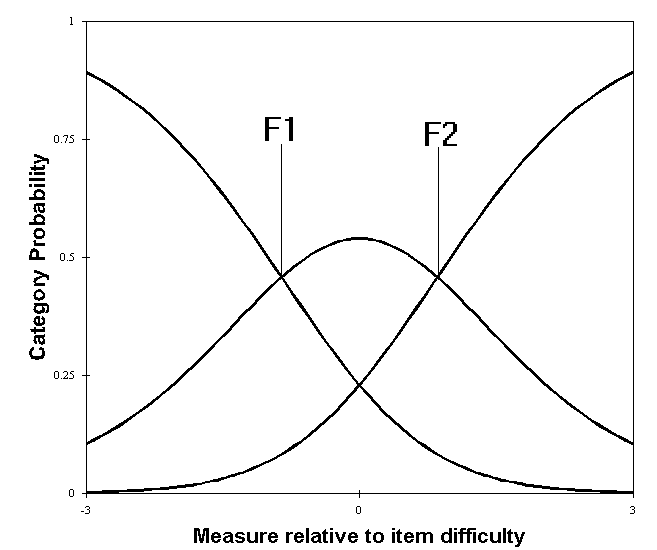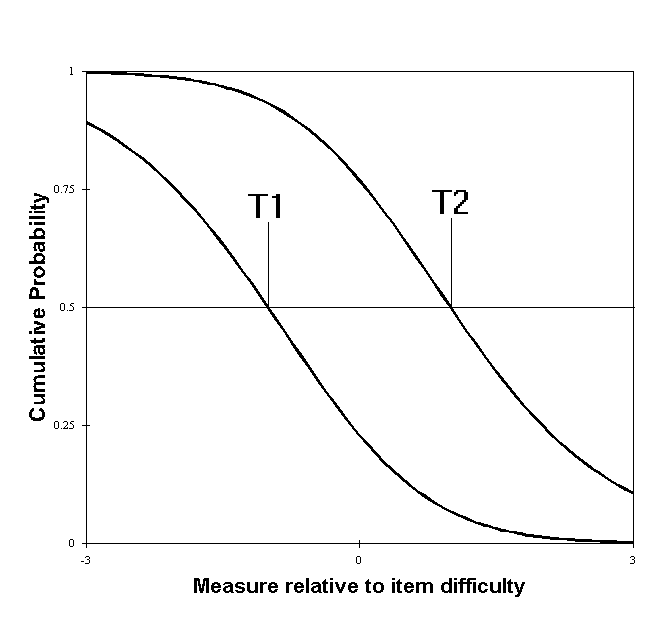
Rating scale category boundaries can be conceptualized in a number of ways. L. L. Thurstone (1928) describes the computation of .50 cumulative proportions as "scale values." These scale values are now referred to as Thurstone thresholds. They are also the parameters in the "Graded Response" model.
Rasch rating scale structures are parameterized using the points of equal-probability of adjacent categories, rather than the points of equal probability of accumulated category probabilities. Nevertheless, in communicating Rasch findings, it can be convenient to represent Rasch rating scale functioning in terms of Thurstone- type thresholds.
Rasch polytomous models, such as Andrich "rating scale" or Masters "partial credit" models have the form:

| 1 |
with the usual notation conventions, and Fg0 = 0. Fgj parameterizes the "Rasch-Andrich threshold" or "step", the point of equal probability of categories j-1 and j. The subscript "g" indicates the manner in which the set of {Fgj} parameters relates to the n or i parameters. For the Andrich "rating scale" model, "g" signifies all items. For the Masters' "Partial Credit" model, "g" signifies item i. For Ben Wright's "Style" model, "g" signifies person n. For an instrument in which different groups of items share common rating scales, "g" identifies the item groups.
Let the Rasch-Thurstone-type thresholds be identified as {Tgj} relative to item difficulty, Di. Then

| 2 |
for j=1,m. So that, multiplying through by the normalizer,

| 3 |
Then let

| 4 |
so that, for each of j=1,m,

| 5 |
If the Tgj are specified, then the tj are known, and the ck can be obtained by solving the m simultaneous equations. From the ck, the Fgh can be computed directly. Thus a polytomous Rasch model can be parameterized in terms of Thurstone-type thresholds using matrix notation and Cramer's rule.
On the other hand, if the Fgh are specified, then the ck are known. Each of the m equations becomes a polynomial in tj. The required root always exists. The lower bound of the search for tj is zero (when the polynomial must be positive), and tj can be increased until the polynomial becomes negative. When the value of tj has been found for which the equation is well enough satisfied, then Tgj is computed.
A 3 category, so two threshold, item has Rasch-Andrich thresholds -0.85, 0.85. The lower Rasch-Thurstone-type Threshold is given by j=1:
|
| 6 |
so that t1 = 0.37, and T1 is -1.0. By symmetry, T2 is +1.0.
Working backwards for the Rasch-Andrich thresholds, if the Rasch-Thurstone-type thresholds are -1, +1, then
|
| 7 |
So that F1 = loge(1/(e1 - e-1)) = -.85, and F2 = +.85.
John M. Linacre
Thurstone L.L. (1928) Attitudes can be measured. American Journal of Sociology, 33, 529-54.

| <

|
Estimating 50% Cumulative Probability (Rasch-Thurstone) Thresholds. Linacre JM. … Rasch Measurement Transactions, 2003, 16:4 p.901
| Forum | Rasch Measurement Forum to discuss any Rasch-related topic |
Go to Top of Page
Go to index of all Rasch Measurement Transactions
AERA members: Join the Rasch Measurement SIG and receive the printed version of RMT
Some back issues of RMT are available as bound volumes
Subscribe to Journal of Applied Measurement
Go to Institute for Objective Measurement Home Page. The Rasch Measurement SIG (AERA) thanks the Institute for Objective Measurement for inviting the publication of Rasch Measurement Transactions on the Institute's website, www.rasch.org.
| Coming Rasch-related Events | |
|---|---|
| Jan. 16 - Feb. 13, 2025, Fri.-Fri. | On-line workshop: Rasch Measurement - Core Topics (E. Smith, Winsteps), www.statistics.com |
| Apr. 8 - Apr. 11, 2026, Wed.-Sat. | National Council for Measurement in Education - Los Angeles, CA, ncme.org/events/2026-annual-meeting |
| Apr. 8 - Apr. 12, 2026, Wed.-Sun. | American Educational Research Association - Los Angeles, CA, www.aera.net/AERA2026 |
| May. 15 - June 12, 2026, Fri.-Fri. | On-line workshop: Rasch Measurement - Core Topics (E. Smith, Winsteps), www.statistics.com |
| June 19 - July 25, 2026, Fri.-Sat. | On-line workshop: Rasch Measurement - Further Topics (E. Smith, Winsteps), www.statistics.com |
The URL of this page is www.rasch.org/rmt/rmt164e.htm
Website: www.rasch.org/rmt/contents.htm